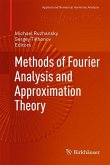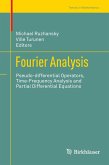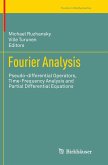The discrete Fourier transform (DFT) is an extremely useful tool that finds application in many different disciplines. However, its use requires caution. The aim of this book is to explain the DFT and its various artifacts and pitfalls and to show how to avoid these (whenever possible), or at least how to recognize them in order to avoid misinterpretations. This concentrated treatment of the DFT artifacts and pitfalls in a single volume is, indeed, new, and it makes this book a valuable source of information for the widest possible range of DFT users. Special attention is given to the one and two dimensional cases due to their particular importance, but the discussion covers the general multidimensional case, too. The book favours a pictorial, intuitive approach which is supported by mathematics, and the discussion is accompanied by a large number of figures and illustrative examples, some of which are visually attractive and even spectacular.
Mastering the Discrete Fourier Transform in One, Two or Several Dimensions is intended for scientists, engineers, students and any readers who wish to widen their knowledge of the DFT and its practical use. This book will also be very useful for 'naive' users from various scientific or technical disciplines who have to use the DFT for their respective applications. The prerequisite mathematical background is limited to an elementary familiarity with calculus and with the continuous and discrete Fourier theory.
Mastering the Discrete Fourier Transform in One, Two or Several Dimensions is intended for scientists, engineers, students and any readers who wish to widen their knowledge of the DFT and its practical use. This book will also be very useful for 'naive' users from various scientific or technical disciplines who have to use the DFT for their respective applications. The prerequisite mathematical background is limited to an elementary familiarity with calculus and with the continuous and discrete Fourier theory.
From the book reviews:
"This book is about the discrete Fourier transform and its practical limitations, pitfalls and artifacts. It is addressed to a wide audience in various scientific and engineering branches, and because of that an intuitive approach supported by mathematics is preferred over a rigorous mathematical treatment." (Biljana Jolevska-Tuneska, Mathematical Reviews, May, 2014)
"This book is for readers who have already taken an introductory course in the theory of discrete and continuous Fourier transforms, and now want to use their new knowledge in various science or engineering fields. ... Amidror (Swiss Federal Institute of Technology in Lausanne) illustrates some of the most frequent mistakes using several hundred figures, which are a central part of the book's approach. ... it may be useful for professional audiences. Summing Up: Recommended. Professionals/practitioners." (M. Bona, Choice, Vol. 51 (9), May, 2014)
"The current book aims to explain the DFT and the various ways one can get into trouble with it. More importantly, it also suggests how to avoid the pitfalls or recognize them and escape any consequent misinterpretation. ... it would be useful resource for practitioners and a valuable addition to libraries. It has a good bibliography and a very nice glossary of signal and image processing terms." (William J. Satzer, MAA Reviews, April, 2014)
"The aim of this textbook is to explain the various artifacts and pitfalls of the DFT. ... This book is mainly written for people with a basic knowledge of DFT, but are not sufficiently familiar with practical limitations and artifacts of DFT. ... The textbook is written in a very informal style and contains numerous examples, figures, and tables. Without any doubt, this book will be a valuable source of information for a wide range of DFT users." (Manfred Tasche, zbMATH, Vol. 1277, 2014)
"This book is about the discrete Fourier transform and its practical limitations, pitfalls and artifacts. It is addressed to a wide audience in various scientific and engineering branches, and because of that an intuitive approach supported by mathematics is preferred over a rigorous mathematical treatment." (Biljana Jolevska-Tuneska, Mathematical Reviews, May, 2014)
"This book is for readers who have already taken an introductory course in the theory of discrete and continuous Fourier transforms, and now want to use their new knowledge in various science or engineering fields. ... Amidror (Swiss Federal Institute of Technology in Lausanne) illustrates some of the most frequent mistakes using several hundred figures, which are a central part of the book's approach. ... it may be useful for professional audiences. Summing Up: Recommended. Professionals/practitioners." (M. Bona, Choice, Vol. 51 (9), May, 2014)
"The current book aims to explain the DFT and the various ways one can get into trouble with it. More importantly, it also suggests how to avoid the pitfalls or recognize them and escape any consequent misinterpretation. ... it would be useful resource for practitioners and a valuable addition to libraries. It has a good bibliography and a very nice glossary of signal and image processing terms." (William J. Satzer, MAA Reviews, April, 2014)
"The aim of this textbook is to explain the various artifacts and pitfalls of the DFT. ... This book is mainly written for people with a basic knowledge of DFT, but are not sufficiently familiar with practical limitations and artifacts of DFT. ... The textbook is written in a very informal style and contains numerous examples, figures, and tables. Without any doubt, this book will be a valuable source of information for a wide range of DFT users." (Manfred Tasche, zbMATH, Vol. 1277, 2014)








